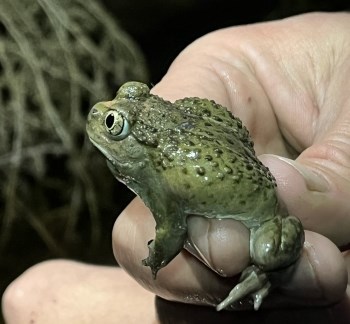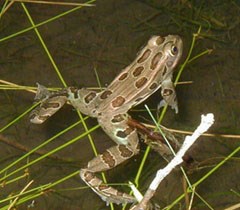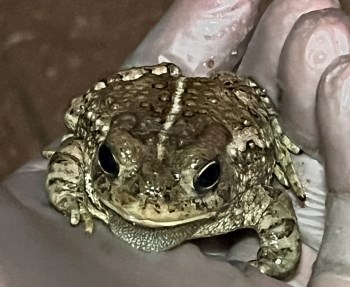
NPS / taryn Preston Like all desert dwellers, amphibians have adapted to the hot, arid environment of the Colorado Plateau. Amphibians, which include frogs, toads, and salamanders, are cold-blooded, or poikilothermic, meaning they regulate their body temperature through external sources rather than by internal metabolism. They have moist, soft skin that aids in temperature, moisture, and gas regulation. Because of these characteristics, amphibians cannot tolerate extreme heat or drought, both common to the desert. In general, amphibians are most active during the warmer months of the year (May to October) and may become more active in the early morning, twilight, or night during hot summer months to conserve energy and moisture. During the day they rest in shady cracks in the rock, underground, or in other dark, damp places. Amphibians require high amounts of moisture for survival and reproduction, and most species in Glen Canyon National Recreation Area (NRA) are found in or near water sources. The canyon treefrog (Hyla arenicolor) is common around the shores and side canyons of Lake Powell and can be found clinging to sandstone walls near water during the day. Canyon treefrogs have a wide distribution throughout the Colorado Plateau and prefer intermittent or permanent streams with rocky bottoms. This species can be identified by its small size, grayish somewhat bumpy skin, and toe pads. 
NPS The northern leopard frog (Rana pipiens), once common along the Colorado River through Glen Canyon, is now irregularly distributed across the Colorado Plateau and requires a permanent water source, preferably with well-developed wetland vegetation. It is a medium-sized green or brown frog with light-bordered spots and complete, pale dorsolateral folds (ridges of skin that run down both sides of the back from the eye area) and is the most cold tolerant of leopard frogs, capable of hibernating in deep water below ice. In Glen Canyon NRA, northern leopard frogs probably belong to remnant populations cut off from traditional dispersal routes by Lake Powell. Glen Canyon Dam is a barrier between populations above and below the dam, creating vulnerable, isolated populations that may not re-colonize if they disappear. Bullfrogs (R. catesbeiana) have not yet been observed in Glen Canyon NRA, but are predators of leopard frogs, and are a nonnative, highly invasive species found in the Colorado River drainage above Lake Powell. The northern leopard frog is disappearing from much of its historic range in North America. Spadefoot toads (which are actually toad-like frogs) also occur in Glen Canyon NRA. Spadefoots have smooth skin, vertical pupils (true toads have horizontal pupils), lack glands on the back of the head for secreting toxic or irritating chemicals, and have a spade-like bump on the underside of each rear foot that is used to dig burrows. Colors can range from gray-brown to reddish-brown to green-brown. The Great Basin spadefoot (Spea intermontana) is common to Glen Canyon NRA. It is possible that the Mexican spadefoot (S. multiplicata) and a hybrid of the Mexican spadefoot and Plains spadefoot (S. bombifrons) occur on the edge of the Glen Canyon area. Spadefoots can be frequently observed away from water. They remain in burrows at the bottom of dried up pools or washes during dry periods and only emerge during heavy rain events. They respond quickly to the sound of thunder from late summer storms and breed in pools formed after rain or in slow streams. 
NPS/ Taryn Preston Two species of true toads have been observed in Glen Canyon NRA, the Woodhouse’s toad (Bufo woodhousii) and the red-spotted toad (B. punctatus). Woodhouse’s toads are a large olive to gray-brown toad with scattered dark spots and a light stripe on the back. The red-spotted toad is a smaller pale gray to tan toad with small red bumps. Both toads are commonly found across the Colorado Plateau. These species are most common along streams in side canyons, but can also occasionally be found crossing the desert as they move between canyons and waterholes. The red-spotted toad sometimes hybridizes with Woodhouse’s toad. Reports of the Great Plains toad remain unconfirmed. You may not see any of these desert dwellers at Glen Canyon NRA, but you may hear their calls. Spend an evening near the water listening to the calls of the Glen Canyon amphibians. A call that sounds like the bleat of a sheep, could be a canyon treefrog. A nasal wail of a crying baby could be the call of a Woodhouse’s toad, while a high-pitched trill announces the red-spotted toad. The calls of northern leopard frogs, include a wide range of sounds from odd chuckles and grunts to long, low snores. The continued need for inventory and monitoring of amphibians in Glen Canyon NRA provides exciting opportunities for scientific research, study, and new knowledge about these species. NRCA 2021: Condition of Glen Canyon's Tributary Rivers and Associated Resources |
Last updated: January 9, 2024
